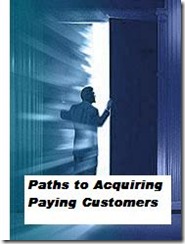 In the globally syndicated BNET blog Sales Machine, Geoffrey James, the author, featured an article called A Roadmap to Winning That "Yes!”
In the globally syndicated BNET blog Sales Machine, Geoffrey James, the author, featured an article called A Roadmap to Winning That "Yes!”
He said it “contains a very clear step-by-step roadmap for developing an initial B2B contact”
Here’s the post By Geoffrey James | July 15, 2011
“My friend (and frequent Sales Machine commentor) Neil Licht recently posted a comment that I think contains a very clear step-by-step roadmap for developing an initial B2B contact. I’ve minimally edited and reformatted his content, which appears below:”
====
Here’s a way to create a path to “Yes!”, based upon my experience in sales and with many clients:
- STEP #1. Do some research and understand the target company, especially how and why your product or solution can help.
- STEP #2. Next, make a short 30 second commercial based on your findings that can quickly and succinctly say what you do, create a reason for listening, relate pertinent issues, benefits and problems solved and let you ask if its something that the prospect needs or would adopt.
- STEP #3. Next find and define who would be right to hear that commercial at the highest level of responsibility and authority, relate to it and give you a true assessment of need/value on the spot. Note: that’s usually not the CEO because the CEO is not focused on running their divisions or departments. Other folks are and can relate to what you have because of that fact.
- STEP #4. Make the phone call to that person and use the 30 second commercial. After the commercial, ask for and qualify the possibility of need or value for what you have explained from the person you are speaking with. Ask it this way “Is this an idea that can benefit you and your company.” (While this is a “yes or no” question, its what you must know at this stage.)
- STEP #5. If the answer is “no” skip to Step 6. If the answer is “yes,” start a brief discussion about how, why, reason, problems solved, impact, etc. This creates a link between you and the person that you have called for the sales process to begin that, if pursued properly, you have the basis of selling value/ROI and not cost and you know it has possibilities to yield a sale based on those criterion. Skip to step 7.
- STEP #6. If no, or you get a weak maybe, stop selling, say thanks and move on to the next prospect. Don’t waste sales time on this one. Say: “Thanks for your time and your honesty. I can see that our solution isn’t applicable to you.” Then ask “Do you know of a colleague that could use my solution.” You might get a great prospect to call or even an introduction. If so, go back to Step 1 and start over.
- STEP #7. Ask about the process for moving forward. Find out who else needs to be involved. Ask: “If we do have a worthwhile solution for you, who along with you would need to be involved in evaluating, adopting and purchasing.” Since your idea or solution has already been acknowledged as worthwhile by the prospect. using this question also lets you ask them for help in moving forward. IMPORTANT: Don’t ask: “Who is the decision maker?” That’s an insulting question because it says to your suspect that you consider him or her a peon.
- STEP #8. After you have found out that they may want to buy your offering, state a rough cost right then to your suspect for the solution and ask if there is a budget for implementing the concept if it’s a worthwhile idea. Don’t even think of continuing the sales process without knowing the answer to this question. It tells you if you can proceed with your idea and also lets you ask and understand the company’s usual process for evaluating and ultimately purchasing your idea is.
- STEP 9: Set up the next step, which will probably involve meeting (in person or on the phone) with other individuals involved in the decision or purchasing process.
Neil Licht CEO HereWeAre, Chief adviser, Acquiring Paying Customers Consultancy Group
callhereweare@verizon.net
http://www.wix.com/ndlicht/hereweare
Youtube video tutorial http://www.youtube.com/user/ndlicht
====
READERS: Huge vote of thanks to Neil for sharing this. (Note: his original comment is in the post “The Fallacy of Calling High.“)